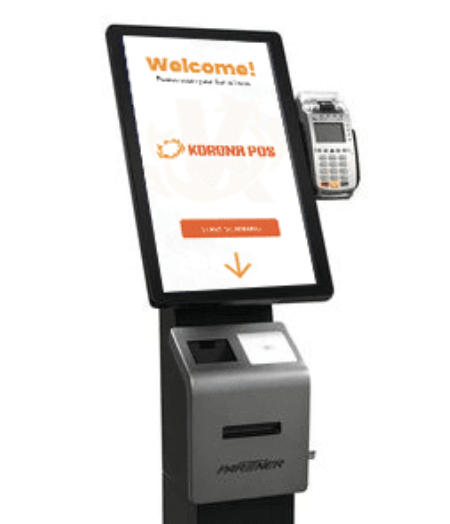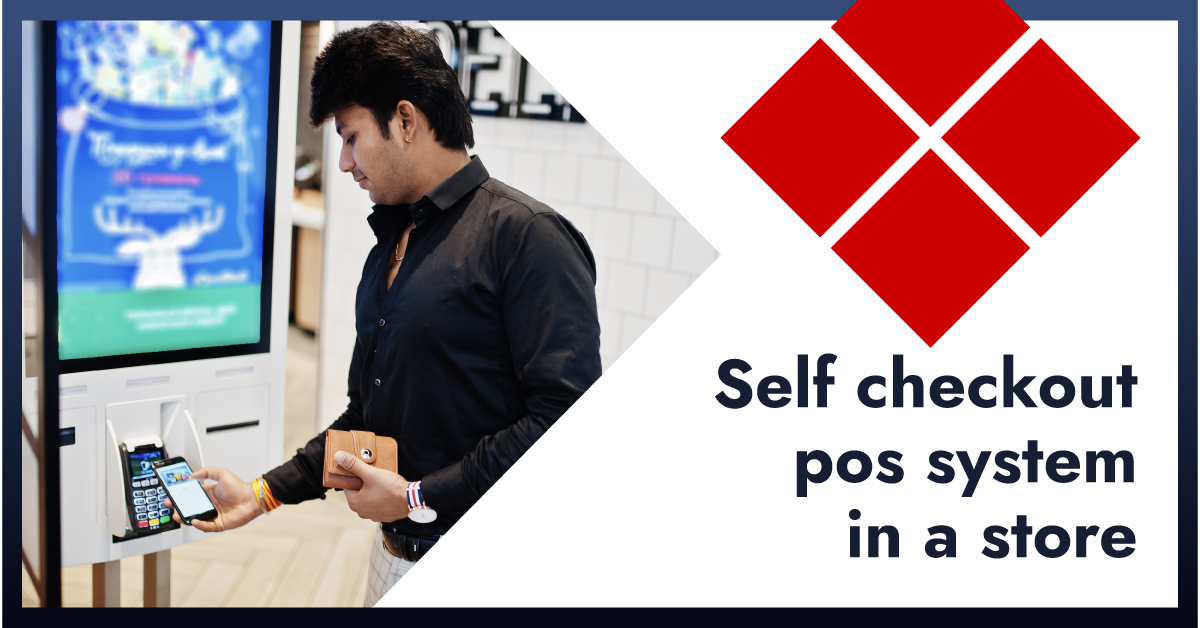Self-checkout systems, also known as self-service checkout systems, are a type of point of sale system that allows customers to process their own transactions without the assistance of a cashier. These systems are becoming increasingly common in grocery stores, discount retailers, places that sell tickets, and some clothing stores. And they’ll certainly become more ubiquitous across various industries in the near future.
But what exactly are these self-checkout POS systems, and how do they benefit customers and retailers? This article will explore self-checkout, why retail stores implement them, how the systems work, their pros and cons, future innovations, and more.
Reasons Why Retail Stores Implement Self Checkout

There are several key reasons why major retailers are choosing to install self-checkout POS systems in their stores:
Reduces Labor Costs
One of the main incentives for self-checkout systems is that they significantly reduce the labor costs associated with staffing traditional cashier checkout lanes. These systems allow one staff member to monitor 4-6 self-checkout kiosks simultaneously rather than having dedicated cashiers at each checkout lane. This translates to major labor cost savings over time, especially for high-volume stores.
Faster Checkout Process
When shoppers use self-checkout, they avoid lines and can process their transactions more quickly. This is more convenient for the customer and allows stores to process more transactions during peak times like lunch hours and holidays when long cashier lines tend to form. A quicker turnaround of customers in the checkout line is highly beneficial to any retail store.
Increased Customer Autonomy
Some shoppers prefer self-checkout systems because they value their privacy and autonomy during checkout. Self-checkout allows them to bag items as they choose, process coupons and tenders at their own pace, and avoid conversing with a cashier. Shoppers have greater control during the entire transaction.
Ability to Process More Transactions
During the busiest times like Christmas, Black Friday sales events, and other holidays, self-checkout systems give retailers the ability to process far more customer transactions because more stations are available. This keeps customers moving through quickly rather than stuck standing in frustrating lines.
How Self-Checkout POS Systems Work?
The self-checkout process functions using the following key hardware and software elements:
Hardware
- Self-checkout kiosk: This is the main terminal where customers interact to scan items, view the total transaction cost, select payment methods (like credit card or Apple Pay), and finish processing the sale. The kiosk includes a monitor, scanner, payment terminal, receipt printer, and bagging area.
- Barcode scanner: A barcode scanner is used to scan each item’s UPC barcode in order to capture the item detail and add it to the total transaction cost.
- Security scales: A sensitive weighing scale ensures that the weight of scanned items matches what is expected. This prevents substitution errors. If an item’s weight doesn’t match, the kiosk will alert the customer and/or staff member to intervene.
- Software: The self-checkout system runs software that tallies the cost of items scanned, communicates with inventory systems about pricing and item details, processes electronic payments, and allows the transaction to finish once tendered.
Process
There steps to the self-checkout process are quite simple, but here we’ve broken them into 10 clearly defined items.
- A customer arrives at a self-checkout kiosk with items they wish to purchase.
- For each item, the customer scans the barcode on the product packaging.
- With each successful scan, item details, like product name, pricing, weight, and more, auto-populate on the checkout terminal.
- If an item doesn’t scan properly or needs age verification, assistance is requested from the self-checkout attendant monitoring that area.
- The customer places each item in the designated bagging area, which is measured by security scales (and sometimes cameras) to ensure accuracy.
- Once all merchandise is scanned, the customer selects a payment method to render payment on the total balance due.
- Accepted tenders include credit cards, debit cards, gift cards, and mobile wallet methods like Apple Pay and Google Pay. Cash may or may not be enabled depending on the specific retailer’s approach.
- Any errors regarding un-scanned items or weight discrepancies must be resolved before finalizing the transaction.
- Upon successful payment processing, the customer’s receipt prints for retrieval and the transaction finishes.
- For certain restricted items, like alcohol, tobacco, or lottery tickets, staff assistance and manual override are required before allowing a self-checkout transaction to proceed.
Role of Staff
Although self-checkout systems allow customers to complete transactions independently, staff assistance is critical for optimizing system use:
- Providing guidance: Staff members remain available within visual proximity to offer guidance with using the self-checkout equipment, rectifying errors, approving restricted items, and answering general questions.
- Monitoring transactions: Staff must continually observe self-checkout area activity to ensure users properly scan all merchandise before bagging, intervene with errors that halt transactions, inspect high theft categories, and mitigate attempted theft.
- Managing exceptions: There are certain issues that require staff assistance and will slow down the process – a translation that requires proof of age, manual entry of product codes, unexpected barcode issues, POS overrides, to name a few.
So while self-checkout does aim to streamline checkout and reduce labor compared to traditional cashiered lanes, attentive staff still play a pivotal role in maintaining the success of the systems.
Pros and Cons of Using Self Checkout POS System
As with most innovations in retail technology, self-checkout systems come with both significant benefits as well as challenges that must be navigated:
Benefits
- Expedited checkout speed: By enabling customers to scan and pay for their own orders, self-checkout provides faster transaction completion versus cashiered lanes, saving customers valuable time.
- Heightened personal privacy: Customers who prefer privacy over social interaction during checkout enjoy the independent environment and discretion that self-checkout allows.
- Avoiding long lines: Self-checkout systems eliminate long waiting lines during peak hours when only limited cashier lanes are open. Customers can proceed directly to an available self-checkout kiosk.
Challenges
- Increased risk of theft: Because a cashier does not directly handle self-checkout, this, unfortunately, leaves more potential for intentional or accidental theft if security features are not sufficient. Retailers must implement vigilant policies, procedures, and technology to mitigate this risk.
- Reliance on employee oversight: Self-checkout units still require direct employee monitoring and interventions when exceptions arise. This reduces some of the labor-saving upside. There is also more pressure on staff to uphold security standards.
- Limited payment options: Some self-checkout units may only accept credit/debit/gift cards or mobile payments, not cash, depending on system sophistication. Others restrict high-dollar denominations. This impacts flexibility for some shoppers.
- High-produce inputs: Self-checkouts may encounter difficulties accurately weighing and identifying loose produce like fruits and vegetables without barcodes attached. This can frustrate shoppers purchasing many fresh foods unless alternate approaches are supported.
Future Self Checkout Innovations
While self-checkout capabilities today meet most core transaction requirements in retail environments, product builders envision more advanced functionality on the horizon:
- Scan-and-Go Mobile Checkout: Walmart and other big box retailers now offer “scan-and-go” applications where shoppers scan UPC barcodes with a mobile device as they add items to their cart. Upon completion, they finalize payment directly through the app. This creates maximum checkout speed.
- Cashier-Less Stores: Technology giants like Amazon and Microsoft are pioneering completely cashier-less retail stores where no checkout is required. Instead, overhead cameras, sensors on shelves, and computer vision identify what customers add to their cart so their account is automatically billed shortly after leaving the store. This represents the most frictionless self checkout experience for busy shoppers valuing speed and convenience above all. Amazon Go has already launched over 30 locations in major cities using this automated checkout model.
The options for self-service retail transactions will only expand as technology develops intuitive ways to remove checkout barriers while balancing cost and security.
Self Checkout POS system in a Retail With KORONA POS by COMBASE USA
COMBASE USA has developed an innovative self-checkout POS system called KORONA POS. This kiosk software integrates with advanced RFID technology for quick and efficient checkout. Customers can pay for all their items without scanning each individually, saving everyone time.
In addition to retail stores, the self-service ticketing function makes this POS system well-suited for events, attractions, and entertainment venues that require tickets. Rather than waiting in line, customers can walk right up to a kiosk and securely purchase their tickets in just seconds via this contactless payment solution.
With KORONA’s self-checkout kiosks, businesses can significantly reduce labor costs and long lines. The system is versatile enough to service customers in retail stores, quick-service restaurants, entertainment venues, and anywhere requiring quick, automated transactions. By implementing this innovative POS software, COMBASE USA allows establishments to run much more efficiently while providing customers with a smooth, speedy checkout process. Click here to get started with KORONA’s self-checkout kiosks.


Recent Comments